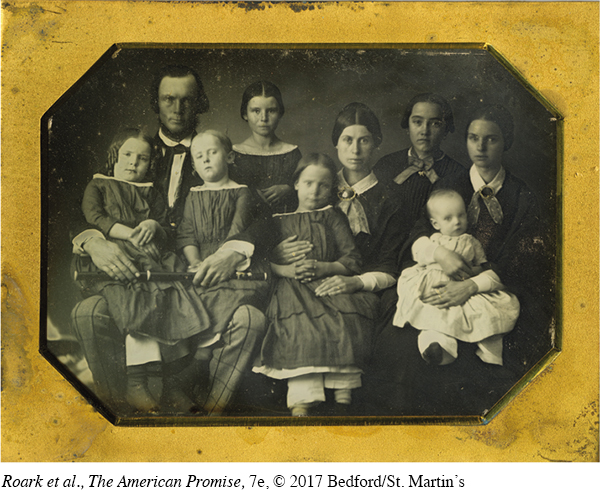The American Promise: Printed Page 328
The American Promise, Value Edition: Printed Page 300
The American Promise: A Concise History: Printed Page 345
The Mormon Exodus
The American Promise: Printed Page 328
The American Promise, Value Edition: Printed Page 300
The American Promise: A Concise History: Printed Page 345
Page 328Not every wagon train heading west was bound for the Pacific Slope. One remarkable group of religious emigrants halted near the Great Salt Lake in what was then Mexican territory. After years of persecution in the East, the Mormons fled west to find religious freedom and communal security.
In the 1820s, an upstate New York farm boy named Joseph Smith Jr. said that he was visited by an angel who led him to golden tablets buried near his home. With the aid of magic stones, he translated the mysterious language on the tablets to produce The Book of Mormon, which he published in 1830. It told the story of an ancient Hebrew civilization in the New World and predicted the appearance of an American prophet who would reestablish Jesus Christ’s undefiled kingdom in America. Converts, attracted to the promise of a pure faith in the midst of antebellum America’s social turmoil and rampant materialism, flocked to the new Church of Jesus Christ of Latter-
Neighbors branded Mormons heretics and drove Smith and his followers from New York to Ohio, then to Missouri, and finally in 1839 to Nauvoo, Illinois, where they built a prosperous community. But after Smith sanctioned “plural marriage” (polygamy), non-
The American Promise: Printed Page 328
The American Promise, Value Edition: Printed Page 300
The American Promise: A Concise History: Printed Page 345
Page 329The embattled church turned to an extraordinary new leader, Brigham Young, who oversaw a great exodus. In 1846, traveling in 3,700 wagons, 12,000 Mormons made their way to Iowa and then, the following year, to their new home beside the Great Salt Lake. Young described the region as a barren waste, “the paradise of the lizard, the cricket and the rattlesnake.” Within ten years, however, the Mormons developed an irrigation system that made the desert bloom. Under Young’s stern leadership, the Mormons built a thriving community using cooperative labor, not the individualistic and competitive enterprise common among most emigrants.
In 1850, the Mormon kingdom was annexed to the United States as Utah Territory. Shortly afterward, Brigham Young announced that many Mormons practiced polygamy. Although only one Mormon man in five had more than one wife (Young had twenty-
